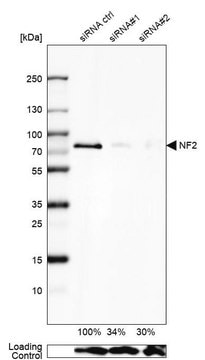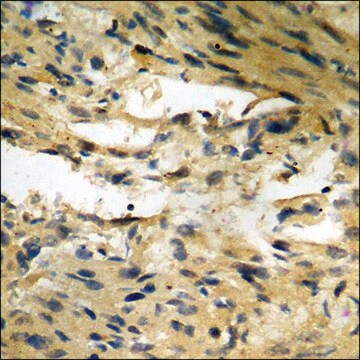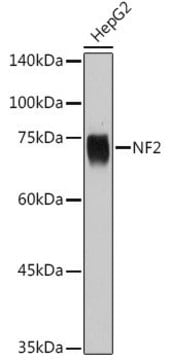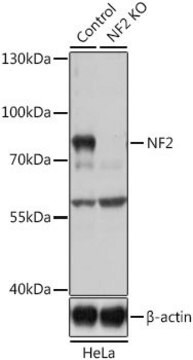MABN1786
Anti-Merlin (NF2) Antibody, clone 1C4
clone 1C4, from mouse
Synonym(e):
Merlin, Moesin-ezrin-radixin-like protein, Neurofibromin-2, Schwannomerlin, Schwannomin
About This Item
Empfohlene Produkte
Biologische Quelle
mouse
Qualitätsniveau
Antikörperform
purified antibody
Antikörper-Produkttyp
primary antibodies
Klon
1C4, monoclonal
Speziesreaktivität
rat, mouse, human
Methode(n)
immunocytochemistry: suitable
immunoprecipitation (IP): suitable
western blot: suitable
Isotyp
IgG1κ
NCBI-Hinterlegungsnummer
UniProt-Hinterlegungsnummer
Versandbedingung
ambient
Posttranslationale Modifikation Target
unmodified
Angaben zum Gen
human ... NF2(4771)
Allgemeine Beschreibung
Spezifität
Immunogen
Anwendung
Neurowissenschaft
Immunocytochemistry Analysis: A representative lot detected merlin cellular distribution and HEI10 co-localization in a cell cycle-dependent manner by fluorescent immunocytochemistry staining of 3.5% paraformaldehyde-fixed U2OS human osteosarcoma cells (Grönholm, M., et al. (2006). Oncogene. 25(32):4389-4398).
Immunocytochemistry Analysis: A representative lot detected merlin cellular localization by fluorescent immunocytochemistry staining of 3.5% paraformaldehyde-fixed embryonic E16 rat neurons. Merlin was seen co-localized with RI to the cell body and extensions in a punctate pattern (Grönholm, M., et al. (2003). J. Biol. Chem. 278(42):41167-41172).
Immunocytochemistry Analysis: A representative lot detected merlin cellular localization by fluorescent immunocytochemistry staining of 4% paraformaldehyde-fixed, 0.1 NP-40-permeabilized human fibroblasts and primary meningioma cells. Merlin co-localized with F-actin at the leading and ruffling edges, but not at the stress fiber. No merlin co-localization with ezrin or moesin was observed (Gonzalez-Agosti, C., et al. (1996). Oncogene. 13(6):1239-1247).
Immunoprecipitation Analysis: A representative lot co-immunoprecipitated N-WASP with merlin from HEK293T cell lysate (Manchanda, N., et al. (2005). J. Biol. Chem. 280(13):12517-12522).
Western Blotting Analysis: A representative lot detected the presence of wild-type, but not L64P, merlin in the EGFR immunoprecipitates from Nf2-/- MEFs infected by adenovirus to express either wild-type or L64P merlin (Curto, M., et al. (2007). J. Cell Biol. 177(5):893-903).
Western Blotting Analysis: A representative lot detected a reduced merlin level in EGFR immunoprecipitate from mouse liver-derived epithelial cells (LDCs) upon shRNA-mediated NHE-RF1, but not NHE-RF2 knockdown. Merlin association with Ezrin was not affected by NHE-RF1 knockdown (Curto, M., et al. (2007). J. Cell Biol. 177(5):893-903).
Western Blotting Analysis: A representative lot detected a ~72 kDa merlin band in rat newborn fibroblast (RNF) and S-16 rat Schwann cell lysates, as well as a ~66 kDa merlin band in murine NIH/3T3 and human MRC-5 fetal fibroblast lystes without cross-reactivity toward the three ERM protein family members, ezrin, radixin, and moesin (Gonzalez-Agosti, C., et al. (1996). Oncogene. 13(6):1239-1247).
Qualität
Western Blotting Analysis: 4 µg/mL of this antibody detected Merlin (NF2) in 10 µg of HEK293 cell lysate.
Zielbeschreibung
Physikalische Form
Lagerung und Haltbarkeit
Sonstige Hinweise
Haftungsausschluss
Sie haben nicht das passende Produkt gefunden?
Probieren Sie unser Produkt-Auswahlhilfe. aus.
Lagerklassenschlüssel
12 - Non Combustible Liquids
WGK
WGK 1
Flammpunkt (°F)
Not applicable
Flammpunkt (°C)
Not applicable
Analysenzertifikate (COA)
Suchen Sie nach Analysenzertifikate (COA), indem Sie die Lot-/Chargennummer des Produkts eingeben. Lot- und Chargennummern sind auf dem Produktetikett hinter den Wörtern ‘Lot’ oder ‘Batch’ (Lot oder Charge) zu finden.
Besitzen Sie dieses Produkt bereits?
In der Dokumentenbibliothek finden Sie die Dokumentation zu den Produkten, die Sie kürzlich erworben haben.
Unser Team von Wissenschaftlern verfügt über Erfahrung in allen Forschungsbereichen einschließlich Life Science, Materialwissenschaften, chemischer Synthese, Chromatographie, Analytik und vielen mehr..
Setzen Sie sich mit dem technischen Dienst in Verbindung.








